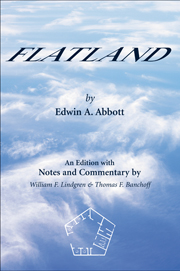Book contents
- Frontmatter
- Contents
- Acknowledgments
- Introduction
- Flatland with Notes and Commentary
- Part I This World
- 1 Of the Nature of Flatland
- 2 Of the Climate and Houses in Flatland
- 3 Concerning the Inhabitants of Flatland
- 4 Concerning the Women
- 5 Of our Methods of Recognizing one another
- 6 Of Recognition by Sight
- 7 Concerning Irregular Figures
- 8 Of the Ancient Practice of Painting
- 9 Of the Universal Colour Bill
- 10 Of the Suppression of the Chromatic Sedition
- 11 Concerning our Priests
- 12 Of the Doctrine of our Priests
- Part II Other Worlds
- Epilogue by the Editor
- Continued Notes
- Appendix A Critical Reaction to Flatland
- Appendix B The Life and Work of Edwin Abbott Abbott
- Recommended Reading
- References
- Index of Defined Words
- Index
2 - Of the Climate and Houses in Flatland
Published online by Cambridge University Press: 05 August 2013
- Frontmatter
- Contents
- Acknowledgments
- Introduction
- Flatland with Notes and Commentary
- Part I This World
- 1 Of the Nature of Flatland
- 2 Of the Climate and Houses in Flatland
- 3 Concerning the Inhabitants of Flatland
- 4 Concerning the Women
- 5 Of our Methods of Recognizing one another
- 6 Of Recognition by Sight
- 7 Concerning Irregular Figures
- 8 Of the Ancient Practice of Painting
- 9 Of the Universal Colour Bill
- 10 Of the Suppression of the Chromatic Sedition
- 11 Concerning our Priests
- 12 Of the Doctrine of our Priests
- Part II Other Worlds
- Epilogue by the Editor
- Continued Notes
- Appendix A Critical Reaction to Flatland
- Appendix B The Life and Work of Edwin Abbott Abbott
- Recommended Reading
- References
- Index of Defined Words
- Index
Summary
As with you, so also with us, there are four points of the compass North, South, East, and West.
There being no sun nor other heavenly bodies, it is impossible for us to determine the North in the usual way; but we have a method of our own. By a Law of Nature with us, there is a constant attraction to the South; and, although in temperate climates this is very slight – so that even a Woman in reasonable health can journey several furlongs northward without much difficulty – yet the hampering effect of the southward attraction is quite sufficient to serve as a compass in most parts of our earth. Moreover the rain (which falls at stated intervals) coming always from the North, is an additional assistance; and in the towns we have the guidance of the houses, which of course have their side-walls running for the most part North and South, so that the roofs may keep off the rain from the North. In the country, where there are no houses, the trunks of the trees serve as some sort of guide. Altogether, we have not so much difficulty as might be expected in determining our bearings.
Yet in our more temperate regions, in which the southward attraction is hardly felt, walking sometimes in a perfectly desolate plain where there have been no houses nor trees to guide me, I have been occasionally compelled to remain stationary for hours together, waiting till the rain came before continuing my journey.
- Type
- Chapter
- Information
- FlatlandAn Edition with Notes and Commentary, pp. 20 - 25Publisher: Cambridge University PressPrint publication year: 2009



